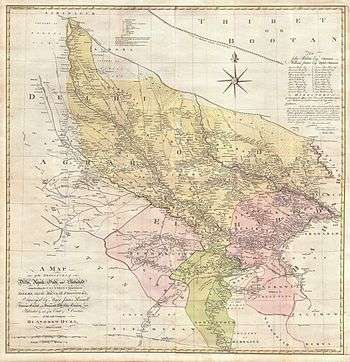Patparganj
| Patparganj Gharonda Neemka Bangar alias Patpar Ganj | |
|---|---|
| city | |
 Patparganj Location in India | |
| Coordinates: 28°44′03″N 77°16′22″E / 28.73419°N 77.27283°ECoordinates: 28°44′03″N 77°16′22″E / 28.73419°N 77.27283°E | |
| Country |
|
| Union Territory | Delhi |
| District | East Delhi |
| Population (2001) | |
| • Total | 34,409 |
| Languages | |
| • Official | Hindi, English |
| Time zone | IST (UTC+5:30) |
| PIN | 110091 |
Patparganj is a locality situated in East Delhi District of the National Capital Territory of Delhi, India.
Patparganj has remained the Delhi Legislative Assembly constituency with East Delhi, Lok Sabha constituency, from 1993 to 2008,[1] and remained after the delimitation of 2008.[2]
History
In the 18th century, Patparganj was a flourishing town and an important grain market of Delhi, where wholesale grain merchants stayed and large enclosures were built to store grain from the doab region and ferried across Yamuna River into Paharganj market, and the walled city of Shahjahanabad (Old Delhi) markets.[3] Towards the end of the reign of Ahmad Shah as his political fortunes declined, and Delhi was wrought by internal fighting, the Mughal empire owed a debt of 15 lakhs to the Najib Khan Rohilla and Bahadur Khan Balauch, thus a settlement was reached and the revenue of village in the Ganges–Yamuna doab was assigned to them. However, on November 26, 1753, they left Delhi. After crossing the Yamuna, they captured Patparganj and seized the headman and the toll-offices. They left only after they received a ransom of Rs. 35,000.[4] Much of the town was destroyed during the period.[3]
In later history, Patparganj was the location of the Battle of Delhi, which took place on September 11, 1803 during the Second Anglo-Maratha War, between British troops under General Lake, and Marathas of Scindia's army under General Louis Bourquin,[5] also giving the battle its local name, Battle of Patparganj. After the British victory, the city of Delhi surrendered three days later. Patparganj was almost a deserted town for years to come.[6][7] A monument was later erected at the site, marked out by a surrounding ditch, commemorating Maj. Middleton (3rd Bengal Cavalry), Cornet Sanguine (27th Light Dragoons) and British soldiers who fell during the battle.[8] The monument today stands as a well maintained sandstone slab at the Noida Golf Course and maintained by the authority.[9]
Post-independence, Patparganj saw rapid development as Delhi spilled in trans-Yamuna, and by the 1990s, many apartment complex and society apartment block had come up. Meanwhile, 175 acres of land was allocated to various societies, previously earmarked for the development of industrial area in the Delhi Master Plan.[10] In 2010, a 690-m long six-lane flyover opened near the Patparganj Industrial Area', between Anand Vihar and Ghazipur crossing, to decongest traffic in the area.[11]
Overview
Patparganj (Indraprastha Extension) is home to a large number of group housing societies, and many mutli-storeyed apartment blocks.[12] Well-connected with neighbouring residential colonies like, its nearby areas are Preet Vihar, Nirman Vihar, Laxmi Nagar, Pandav Nagar and Mayur Vihar.
Parpartganj is also known for its industrial area known as 'Patparganj Industrial area' [13] A number of well known prominent retired civil servants and former diplomats of India have retired here and had colonies and apartments built for themselves by the Government, for their retirement over here. These are also otherwise popularly known as the IFS (Indian Foreign Service) and the IAS (Indian Administrative Service) colonies.
Over the years, Madhu Vihar has developed into a busy market place of Patparganj.[14] Balco market, named after a neighbouring apartment of the same name, is another popular community market in Patparganj that has ATMs, banks, stationery shops, Guitar School Guitarmonk, a Mother Dairy outlet and various other shops.[15] Established in 2005, Max Hospital at Patparganj, was the first multi-specialty tertiary care centre in East Delhi.[16]
Demographics
As of 2001 India census,[17] patparganj had a population of 34,409. Males constitute 55% of the population and females 45%. Patparganj has an average literacy rate of 70%, higher than the national average of 59.5%: male literacy is 74%, and female literacy is 64%. In Patparganj, 15% of the population is under 6 years of age.
References
- ↑ "List of Parliamentary & Assembly Constituencies, General Election to the Lok Sabha, 2004" (PDF). Government of Delhi website. Archived from the original (PDF) on October 6, 2011.
- ↑ "Delimitation of Parliamentary and Assembly Constituencies Order, 2008" (PDF). The Election Commission of India. p. 556.
- 1 2 Stephen P. Blake (2002-04-30). "Suburbs – Paharganj". Shahjahanabad: The Sovereign City in Mughal India 1639–1739. Cambridge University Press. p. 58. ISBN 978-0-521-52299-1.
- ↑ Jadunath Sarkar (1991-01-01). "The Downfall of Ahmad Shah". Fall Of The Mughal Empire, Vol. I. Orient Blackswan. p. 252. ISBN 978-81-250-1149-1.
- ↑ "Patparganj – then and now!". The Hindu. Feb 26, 2007.
- ↑ Fanshawe, p. 69
- ↑ Fanshawe, p. 232
- ↑ Jadunath Sarkar (1992-01-20). Fall Of The Mughal Empire Vol. 5 (1789–1803). Orient Blackswan. p. 245. ISBN 978-0-86131-749-3.
- ↑ "A war memorial lost in time". Hindustan Times. January 16, 2010.
- ↑ P. C. Kapoor (1991). Civic affairs, Volume 39. The Citizen Press. p. 51.
- ↑ "Six-lane flyover near Patparganj opens today". The Times of India. Aug 29, 2010.
- ↑ "Check out society flats in Dwarka, Patparganj". Indian Express. Apr 28, 2006.
- ↑ "Factory owners protest at DERC hearing". The Times of India. Jul 7, 2011.
- ↑ "Parking woes for Patparganj shoppers". The Times of India. Jan 20, 2005.
- ↑ http://wikimapia.org/9231039/Balco-Market
- ↑ Max Healthcare Institute - History
- ↑ "Census of India 2001: Data from the 2001 Census, including cities, villages and towns (Provisional)". Census Commission of India. Archived from the original on 2004-06-16. Retrieved 2008-11-01.
- H.C. Fanshawe (1998-04-01). Delhi, past and present. Asian Educational Services. ISBN 978-81-206-1318-8.
